Intel's Pentium M on the Desktop - A Viable Alternative?
by Anand Lal Shimpi on February 7, 2005 4:00 PM EST- Posted in
- CPUs
Business/General Use Performance
Business Winstone 2004
Business Winstone 2004 tests the following applications in various usage scenarios:- Microsoft Access 2002
- Microsoft Excel 2002
- Microsoft FrontPage 2002
- Microsoft Outlook 2002
- Microsoft PowerPoint 2002
- Microsoft Project 2002
- Microsoft Word 2002
- Norton AntiVirus Professional Edition 2003
- WinZip 8.1

In business applications, the Pentium M does extremely well - with the 755 offering performance equivalent to that of an Athlon 64 FX-55. This is undoubtedly due to the extremely low latency L2 cache, which matters considerably in business applications.
Office Productivity SYSMark 2004
SYSMark's Office Productivity suite consists of three tests, the first of which is the Communication test. The Communication test consists of the following:"The user receives an email in Outlook 2002 that contains a collection of documents in a zip file. The user reviews his email and updates his calendar while VirusScan 7.0 scans the system. The corporate web site is viewed in Internet Explorer 6.0. Finally, Internet Explorer is used to look at samples of the web pages and documents created during the scenario."
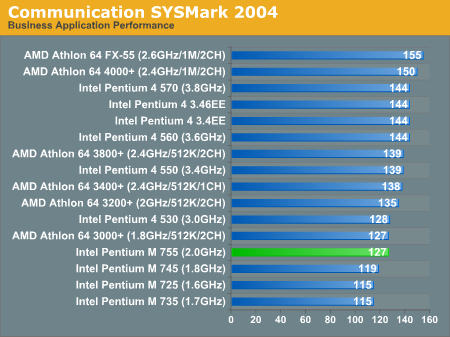
Immediately, we see that the Pentium M can't always do well, as even the 2.0GHz Pentium M 755 can't outperform the Athlon 64 3000+. The communication suite stresses memory bandwidth and latency rather than applications and usage patterns that fit into cache, so the Pentium M loses out big time.
The next test is Document Creation performance, which shows very little difference in drive performance between the contenders:
"The user edits the document using Word 2002. He transcribes an audio file into a document using Dragon NaturallySpeaking 6. Once the document has all the necessary pieces in place, the user changes it into a portable format for easy and secure distribution using Acrobat 5.0.5. The user creates a marketing presentation in PowerPoint 2002 and adds elements to a slide show template."
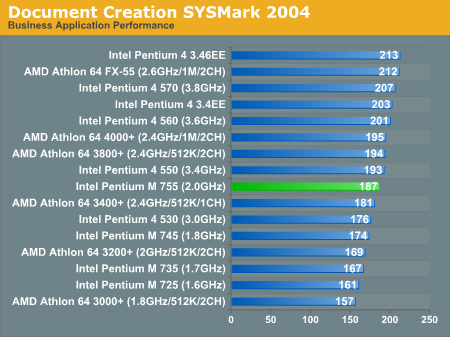
The Pentium M does a bit better in the document creation tests, as they are mostly using applications that will fit within the CPU's cache. However, the introduction of a voice recognition program into the test stresses the Pentium M's floating point performance, which does hamper its abilities here.
The final test in our Office Productivity suite is Data Analysis, which BAPCo describes as:
"The user opens a database using Access 2002 and runs some queries. A collection of documents are archived using WinZip 8.1. The queries' results are imported into a spreadsheet using Excel 2002 and are used to generate graphical charts."
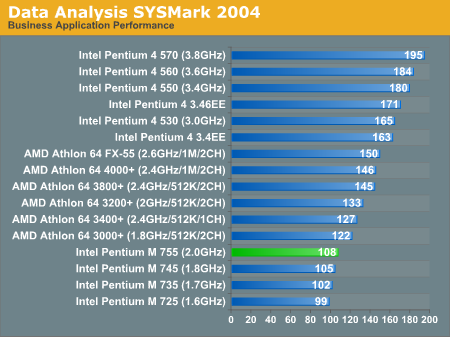
Without a doubt, the inclusion of Access usage patterns in the data analysis suite kills the Pentium M's chances here, as it once again brings up the tail in performance.
Microsoft Office XP SP-2
Here, we see in that the purest of office application tests, performance doesn't vary all too much.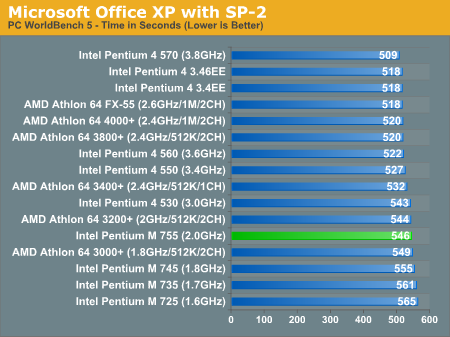
The Pentium M is competitive here, but so are all of the other CPUs.
Mozilla 1.4
Quite possibly the most frequently used application on any desktop is the one that we pay the least amount of attention when it comes to performance. While a bit older than the core that is now used in Firefox, performance in Mozilla is worth looking at as many users are switching from IE to a much more capable browser on the PC - Firefox.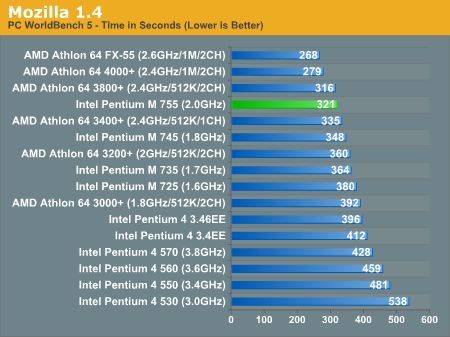
The Pentium M does extremely well here, outperforming both Athlon 64 and Pentium 4 competitors. Only the higher clock speed of the Athlon 64 gives it the overall lead here.
ACD Systems ACDSee PowerPack 5.0
ACDSee is a popular image editing tool that is great for basic image editing options such as batch resizing, rotating, cropping and other such features that are too elementary to justify purchasing something as powerful as Photoshop. There are no extremely complex filters here, just pure batch image processing.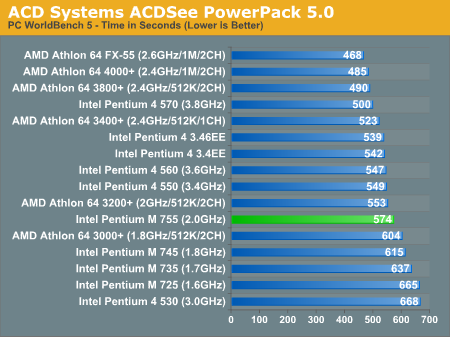
Once again, we see the Pentium M bring up the rear in situations where its low latency L2 cache can't help it.
Winzip
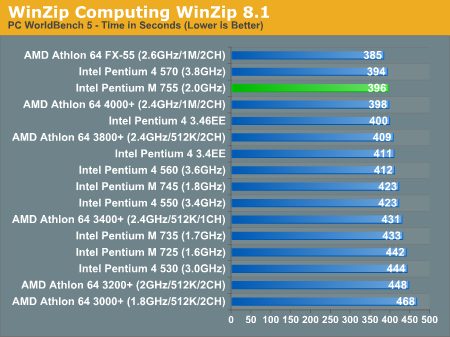
The Pentium M is fairly competitive in the real-world WinZip test - coming in third place overall, but the margin of victory isn't too great.
Let's look at how its peak theoretical performance is under WinRAR's built in benchmark:
WinRAR 3.40
Pulling the hard disk out of the equation, we can get a much better idea of which processors are truly best suited for file compression.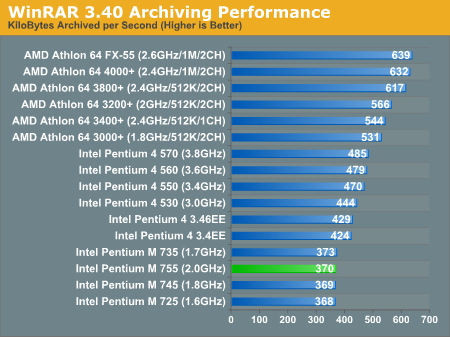
Here, we see that the lack of memory bandwidth really hurts the performance potential of the Pentium M. Luckily, most archiving tasks are usually disk-limited, so the performance differential won't be this bad in reality.










77 Comments
View All Comments
saratoga - Tuesday, February 8, 2005 - link
Overall this artical brings up a lot of the points missing in other Dothan reviews. Very nice work. Too many people have looked at a few benchmarks, bashed Intel for the P4, and missed the whole issue here.Intel isn't stupid. Its obvious they don't think Dothan will work in its current form as a desktop chip, and thats why they're still sticking with Prescott at the moment, and only bring the P-M over much later in a reworked form with Yohan. Assuming they ever do introduce a desktop chip based on the P-M.
Also, siginificant scaling out of Dothan seems unlikely. They'll probably get a few more speed grades out of it, but whoever was saying 3GHz was dreaming. Maybe at 65nm, but that sure as heck won't be dothan, and it won't be for a while yet.
PrinceGaz - Tuesday, February 8, 2005 - link
Well put classy, the P-M is a chip that at least in its current form can never be a desktop processor because of severe weaknesses in several areas.A faster dual-channel chipset will never make up for its poor FPU performance in heavy-duty applications, something I'd heard about many months ago but hadn't seen reliable benchmarks of until now.
If you want to do word-processing or browse the web, I'm sure the P-M will be very efficient. If you want to run the sort of spplications that seriously test a processor and are the reason you'd buy it in the first place for a desktop PC, then the P-M falls far short of the mark, in fact it is so far behind at times that it is embarrasing.
But you don't get anything for nothing, the P-M is great at doing easy stuff very quickly which is what laptops are used ofr mainly; but when the going gets tough, you want a real desktop processor like the A64 to keep things moving.
classy - Tuesday, February 8, 2005 - link
T8000What part don't you understand? The Pentium M has been reviewed all over the net. Out of all the reviews only one reviewer hit 2.8. Everyone else, was similar to Anandtech's results. 2nd I don't no where you been, but every review of an FX55 I have seen it routinely hits 2.8 with no problem. And almost all the lower speeds hit the 2.6-2.7 ballpark. Not mention that a small increase with A64 is much more signifcant than even a modest Intel OC because of the architecture of the A64 cpus. Hey everyone has a favorite cpu, video card, or motherboard maker. But when something is better, its just better. And for anyone to even remotely argue the Pentium M as a challenge to the A64 cpus is a bit silly. This chip reminds me a lot of the old 366@550 celery chips. IF you got a 366 to do 550 it was a great chip because it gave you nice performance for the price. The Pentium M doesn't have a price advantage and is on a platform that is outdated. IF you can overclock it to decent levels it performs pretty good in some aspects but still sucks in many others. The problem is IF. But as I stated ealier IF is out for the evening with MAYBE.
LackofVision - Tuesday, February 8, 2005 - link
I couldn't disagree more with the conclusions in this article.Anyone who can't see the promise of a desktop processor design based on the banias in't going beyond just looking at the numbers. Especially when you start thinking down the road about dual core's and the heat and performance bottlenecks associated with them.
So because the banias can't outperform the p4 or athlon64 in every benchmark, when hamstrung by an outdated chipset, and designed primarily for low power usage, the processor won't be competitive when running on a modern subsystem with a re tuning of the core design to make it more suited to the desktop?
Nothing like comparing apples to oranges and then drawing a conclusion on what a pear tastes like.
jamawass - Tuesday, February 8, 2005 - link
I doubt it, Intel makes huge profits by putting a price premium for mobile processors. They won't jeopardize this for a few enthusiasts.KristopherKubicki - Tuesday, February 8, 2005 - link
FrostAWOL, #51: What's your point? Those HP blade servers run Pentium Ms and there is no mention of Pentium 4 anywhere.Kristopher
HardwareD00d - Tuesday, February 8, 2005 - link
Pentium M = YawnT8000 - Tuesday, February 8, 2005 - link
#52Since it is very rare to see an A64 CPU overclock above the available speeds without subzero cooling, the comparision would likely be between a 2.4 or maybe 2.6 Ghz A64 and a 2.8 Ghz P-M.
Also, P-M CPU's with higher multipliers usually overclock better due to the limited FSB possibilities of the i855 chipset. This could explain why Anand did not reach 2.8 Ghz in this review.
dobwal - Tuesday, February 8, 2005 - link
While i think that this is a good article. Allowing us to see the performance of the dothan in its current state against desktop cpus. Some of the conclusions that are made by the author don't take account of alot factors.1. "The problem is that in the transition to the desktop world, its competitors get much more powerful, while the Pentium M is forced to live within its mobile constraints."
How can this statement be valid. The mobile constraints on the Dothan is never really removed. Nothing is really done to try to make the mobile dothan mimick a (possible) desktop variation of itself. Do you really think there is a chance for a official desktop dothan running at 2.4 with DDR 333 in single channel with 533 FSB. How about re-running these benchmarks along with a 3.2Ghz P4 with DDR 333 (single channel) and a FSB speed of 533.
2. "The fundamental issue is that although the Pentium M is surprisingly competitive with the Athlon 64 on a clock for clock basis, the Pentium M's architecture can't scale to the same clock speeds that the Athlon 64 can. The fact of the matter is that while the Pentium M will hit 2.26GHz by the end of 2005, the Athlon 64 will be on its way to 3.0GHz and beyond."
The fact of the matter is you are comparing the scalability of the king of mobile chips vs. the scalability of the king of desktop chip and making an assumption without taking account of all the factors involved. The fact is we do not know the scalability of the dothan without its mobile constraints. Even more so, we don't know the true scalability of the mobile Dothan. What other mobile cpu offers the same level of performance vs. battery life.
Its more profitable for a company to retard performance increases of its cpu if there is no other cpu that can offer the same level of performance currently or in the near future. Revisions or new steppings increase cost.
AMD is in the same boat with the A64.
How long has A64 been stuck on 2.4Ghz. Most of the latest PR number increases with relation to A64 have come from HT increases, dual channel and moving from 754 to 939. Imagine the scenario of where the Prescott worked as intended and the Tejas was around the corner. Do you think that the A64 would be still at 2.4Ghz or more like 3.0 or 3.2Ghz.
While some of the conclusions could be seen as true under the circumstances of Intel never officially introducing the dothan to the desktop world. Where all we get are mobile Dothans on chipsets with desktop features.
However, these benchmarks can't prove or disprove the viability of a dothan that was devised by Intel to be a desktop competitor.
classy - Tuesday, February 8, 2005 - link
#55IF Intel does this. IF Intel does that. Unfortunately IF left with MAYBE and they went to the movies to see the new #1 movie from Intel, Could Have, But Didn't, starring Mr Dothan CPU. :)